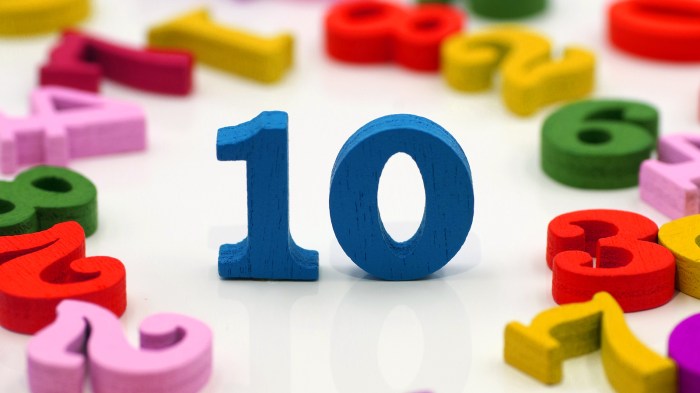12 ways make sure your new years resolution sticks. This guide delves into the science behind why resolutions often fall short, offering practical strategies to ensure your ambitions for the new year become lasting lifestyle changes. From understanding the psychology of goal-setting to creating a supportive environment and developing actionable strategies, we’ll explore everything you need to achieve your New Year’s aspirations.
We’ll explore the common pitfalls of New Year’s resolutions and provide concrete steps to overcome them. We’ll examine the importance of realistic goals, the power of support systems, and effective strategies for maintaining motivation. Learn how to transform fleeting intentions into enduring habits.
Understanding the Psychology of Resolutions
New Year’s resolutions are a common, yet often fleeting, aspiration. Many people embark on these journeys with enthusiasm, but the reality is that maintaining these commitments throughout the year is challenging. This is not a failure of willpower, but rather a reflection of the complex interplay of psychological factors influencing our motivation and behavior. Understanding these factors is crucial for anyone hoping to make their resolutions stick.The allure of a fresh start, coupled with the desire for self-improvement, often fuels the initial commitment to a New Year’s resolution.
However, this enthusiasm can wane as time progresses, leading to a significant drop in motivation and, ultimately, abandonment of the goal. This is often due to a mismatch between the desired outcome and the realistic steps required to achieve it.
Common Reasons for Resolution Failure
The reasons behind resolution failure are multifaceted, stemming from both internal and external factors. A lack of clear definition, unrealistic expectations, insufficient planning, and a lack of accountability are significant contributors. Motivation fluctuates, and external pressures often take precedence over personal goals. Moreover, unresolved underlying issues or a lack of self-awareness can make sustained commitment difficult.
Psychological Factors Influencing Success or Failure
Motivation is not a constant; it fluctuates. Our emotional state, perceived self-efficacy, and the environment all play a role in maintaining motivation. For instance, a challenging work environment, personal setbacks, or significant life changes can significantly impact our ability to stay committed to a resolution. Likewise, a feeling of being overwhelmed by the goal can lead to discouragement and ultimately abandonment.
Emotional and Motivational Elements
Emotions play a significant role in our commitment to resolutions. Fear of failure, feelings of inadequacy, and lack of self-belief can undermine motivation and lead to giving up. Conversely, positive emotions like hope, optimism, and self-compassion can foster a sense of resilience and encourage continued effort. Developing a positive self-image and cultivating a supportive network can enhance the emotional resilience required to overcome challenges and setbacks.
Importance of Realistic Expectations and Goal Setting
Setting unrealistic goals is a major contributor to resolution failure. Break down large, complex goals into smaller, more manageable steps. This approach fosters a sense of accomplishment with each step, which in turn reinforces motivation. Defining clear, measurable, achievable, relevant, and time-bound (SMART) goals is essential for success.
Strategies for Building Self-Efficacy and Confidence
Building self-efficacy, the belief in one’s ability to succeed, is paramount for achieving resolutions. Start with achievable goals, celebrating small victories along the way. Seeking guidance and support from mentors or support groups can provide invaluable encouragement and guidance. Failure should be viewed as an opportunity for learning and adaptation rather than a sign of inadequacy.
Defining Clear and Specific Goals
Resolutions often fall flat because they lack a clear path to success. Vague aspirations, like “be healthier,” are difficult to track and achieve. This section dives into the crucial step of turning broad intentions into concrete, measurable goals, ensuring your resolutions are more likely to become reality.Effective resolutions are not just about
- wanting* something; they are about
- planning* how to get it. By defining specific, measurable, achievable, relevant, and time-bound (SMART) goals, you provide yourself with a roadmap for success. This process transforms a wish list into a practical action plan.
Crafting SMART Goals
To truly make your resolutions stick, translate your intentions into SMART goals. This framework ensures that your aspirations are actionable and attainable.
SMART stands for Specific, Measurable, Achievable, Relevant, and Time-bound.
Specific goals define exactly what you want to accomplish. Measurable goals allow you to track your progress and assess success. Achievable goals are realistic and attainable within your current resources and capabilities. Relevant goals align with your overall values and long-term objectives. Time-bound goals set deadlines, providing structure and motivation.
Examples of Well-Defined Resolutions and SMART Goals
Let’s illustrate this with examples:
- Resolution: Improve fitness.
SMART Goal: Exercise three times a week for 30 minutes, focusing on cardio and strength training, and track progress using a fitness app for six months.
- Resolution: Reduce debt.
SMART Goal: Reduce outstanding credit card debt by $500 in the next three months by creating a detailed budget and prioritizing debt repayment. This includes tracking spending and setting a realistic repayment schedule.
- Resolution: Improve communication with a partner.
SMART Goal: Schedule one dedicated conversation per week with your partner to discuss concerns and address them together within two months.
Categorized Potential Resolutions
Here’s a breakdown of potential resolutions, categorized by area of life:
- Health: Lose weight, improve sleep, increase physical activity, adopt a healthier diet.
- Finances: Reduce debt, save for a down payment, budget effectively, invest consistently.
- Relationships: Strengthen family bonds, improve communication with friends, nurture romantic relationships, foster better professional connections.
- Personal Development: Learn a new skill, improve time management, practice mindfulness, read more books, cultivate positive habits.
Vague vs. Specific Resolutions
The following table contrasts vague resolutions with their SMART goal counterparts, highlighting the difference in clarity and actionability.
| Vague Resolution | Specific, Measurable Resolution |
|---|---|
| “Eat healthier” | “Consume 5 servings of fruits and vegetables daily for 30 days, tracking intake in a food journal.” |
| “Improve finances” | “Reduce monthly spending by 15% by identifying unnecessary expenses and implementing a budget for the next three months.” |
| “Be more organized” | “Designate a specific space for all belongings and implement a system for organizing tasks within the week. This includes daily decluttering and categorization.” |
Creating a Supportive Environment
Resolutions often fail not due to a lack of willpower, but due to a lack of support. A strong network and a motivating environment can significantly boost your chances of success. This section explores how to cultivate such a supportive ecosystem to nurture your resolution journey. Creating a supportive environment isn’t about changing your whole life overnight, but about building consistent habits that make it easier to maintain your resolution.Creating a supportive environment is crucial for maintaining motivation and consistency.
A supportive environment is not just about having people cheering you on; it’s about having a network of individuals who understand your goals and can provide practical assistance. This can range from accountability partners to family members to supportive mentors.
Building a Supportive Network
A robust network of support is vital for sustained motivation. Friends, family, and mentors can provide encouragement, guidance, and a sense of community. Actively reaching out to those who share your values or have experience with similar goals can yield a profound impact on your journey. This involves not only seeking their support but also offering support to them in return.
So, you’ve got your 12 ways to make sure your New Year’s resolution sticks? Great! But sometimes, letting go of baggage is just as important as forging ahead. Consider this: ditching some of the truly useless things in your life, like that collection of vintage cassette tapes you’ll never listen to again, might just free up mental space for your goals.
For a deeper dive into identifying and releasing those non-essential elements, check out this article on 10 extremely useless things you need let your life 10 extremely useless things you need let your life. Once you’ve decluttered your life, you’ll be better equipped to focus on your resolutions and actually make them happen!
A healthy exchange fosters a stronger and more meaningful connection.
So, you’ve got your 12 ways to make sure your New Year’s resolution sticks? That’s fantastic! But what if you could supercharge your commitment by expanding your knowledge? Learning from the best, like at the best places get top grade education for free , could unlock a whole new level of motivation. Ultimately, this deeper understanding will help you stay focused on achieving your resolutions.
Accountability Partners
Accountability partners play a critical role in keeping you on track. They provide a vital check-in mechanism, reminding you of your commitments and helping you stay accountable for your actions. Choosing the right accountability partner is key. Consider someone who shares your goals, understands your challenges, and can provide constructive feedback without being overly critical. This is crucial for a positive and productive relationship.
Supportive Activities and Rituals
Integrating supportive activities and rituals into your routine can reinforce positive habits. These could include daily check-ins with your accountability partner, celebrating milestones, or sharing progress with a supportive group. Rituals can be as simple as having a specific time and place for your goal-related activities, or having a routine before and after exercise. These simple actions create a strong foundation for consistency.
The regularity helps create a positive reinforcement loop, making it easier to maintain the momentum.
Creating a Positive Environment
Your home and work environments significantly impact your ability to stay committed. A clutter-free space, a designated workspace, and a supportive atmosphere at home can make a difference. Minimizing distractions and maximizing focus within your environment can foster a more productive and motivating atmosphere. Positive reinforcement from family and colleagues can also create a strong sense of support.
Encouraging an atmosphere of collaboration and support can lead to higher success rates.
Support System Table
| Support System | Benefits |
|---|---|
| Friends | Emotional support, encouragement, shared experiences |
| Family | Understanding, encouragement, practical assistance |
| Mentors | Guidance, expertise, insights into similar experiences |
| Accountability Partners | Regular check-ins, constructive feedback, motivation |
| Supportive Groups | Shared experiences, encouragement, motivation, sense of community |
| Positive Home/Work Environment | Reduced distractions, increased focus, supportive atmosphere |
Developing Actionable Strategies
Turning your New Year’s resolutions into reality requires a practical approach. Simply stating a goal isn’t enough; you need a roadmap to guide you toward achieving it. This involves breaking down large aspirations into smaller, manageable steps, creating a structured plan, and incorporating daily habits to support your progress. Effective strategies are crucial for sustained motivation and long-term success.To make your resolutions stick, you need a plan that’s both ambitious and achievable.
A detailed action plan allows you to track your progress, adjust your approach as needed, and celebrate milestones along the way. This proactive approach fosters a sense of accomplishment and builds confidence, increasing the likelihood of achieving your desired outcome.
Breaking Down Large Resolutions
A common mistake is tackling a large resolution head-on. This can lead to feeling overwhelmed and discouraged, ultimately hindering progress. Instead, break down your resolution into smaller, more manageable steps. For example, if your resolution is to learn a new language, instead of aiming to become fluent overnight, focus on learning a few basic phrases each week.
This approach makes the goal less intimidating and more attainable.
Developing a Daily or Weekly Action Plan
Creating a structured action plan is essential for maintaining momentum. A daily or weekly action plan provides a clear framework for your activities, making it easier to stay on track. This plan should Artikel specific tasks, estimated time commitments, and anticipated outcomes. Regularly reviewing and adjusting your plan is crucial to accommodate unforeseen circumstances and ensure continued progress.
It’s important to be realistic about the time and resources you have available to ensure that your plan is sustainable.
Practical Daily Habits
Implementing daily habits that support your resolution is key to making it a lasting change. These habits could include reviewing your progress, practicing the skill you’re learning, or simply reflecting on how your actions align with your goals. Small, consistent actions contribute significantly to overall progress. For example, if your resolution is to exercise more, a daily habit could be to walk for 30 minutes.
Figuring out how to make those New Year’s resolutions stick can be tricky, right? Twelve ways to ensure success are definitely helpful, but sometimes, understanding the unique challenges of certain life situations can be just as crucial. For instance, if you’re a stay-at-home dad, you’ll totally relate to the unique pressures and rewards detailed in this article about 10 things only stay home dads would understand.
Ultimately, understanding different perspectives can help us all stay motivated and committed to our goals, no matter what those goals may be, and those 12 ways will certainly help.
The consistent nature of this habit, over time, will contribute significantly to achieving your fitness goals.
Action Plan Templates
| Resolution Type | Action Plan Template |
|---|---|
| Learning a new skill | Daily practice sessions, focusing on specific skill components, and setting realistic progress markers. |
| Improving physical health | Creating a structured workout schedule, tracking nutrition intake, and recording exercise progress. |
| Improving financial stability | Creating a budget, tracking expenses, and setting realistic savings goals. |
| Developing a new habit | Scheduling dedicated time for the habit, creating cues and reminders, and celebrating successes. |
This table offers a glimpse into various action plan templates, highlighting different approaches tailored to various resolution types. It emphasizes the importance of personalization, adapting the structure to the specific resolution and individual circumstances.
Habit Stacking
“Habit stacking is a technique that leverages existing habits to build new ones.”
This technique involves linking a new habit to an existing one. For example, if you already brush your teeth every morning, you could stack the habit of reading a chapter from a book on top of that routine. By associating the new habit with an already established one, you leverage the existing behavioral pattern to build a new, more positive routine.
This method simplifies the process of integrating a new habit into your daily life, significantly increasing the chances of success.
Overcoming Obstacles and Challenges

New Year’s resolutions often falter due to unforeseen obstacles and setbacks. Understanding how to navigate these challenges is crucial for maintaining momentum and achieving your goals. This section delves into common roadblocks, effective strategies for overcoming them, and techniques for fostering self-compassion during difficult times.Successfully navigating the complexities of life’s challenges is a critical component of long-term success.
Resilience and adaptability are essential traits for achieving meaningful personal growth and fulfilling ambitions. This often requires acknowledging setbacks as opportunities for learning and growth, rather than viewing them as failures.
Common Obstacles to Resolution Success
Often, well-intentioned resolutions are thwarted by external pressures, internal conflicts, or simply a lack of realistic planning. Common obstacles include a lack of time management skills, inconsistent motivation, and a lack of support systems. Another common issue is a lack of clear strategies and support systems.
Strategies for Dealing with Setbacks and Relapses
Setbacks are inevitable; the key is to view them not as failures, but as opportunities for course correction. Strategies for managing setbacks include identifying the root cause of the setback, adjusting the resolution’s scope or timeline, and reframing the setback as a learning experience. Developing a flexible approach is paramount to maintaining progress.
Self-Compassion and Maintaining Motivation
Maintaining motivation during challenging times requires self-compassion. This involves acknowledging that setbacks are normal and that progress is not always linear. Practice self-kindness and avoid harsh self-criticism. Recognize that progress is often a process of small steps, not a sprint.
Examples of Successful Strategies
One successful strategy involves breaking down large goals into smaller, more manageable steps. This approach allows for a more gradual integration of the resolution into daily life. Another example is creating a support network. Sharing your goals with friends or family members can provide accountability and encouragement. Finally, building a system of incentives, rewards, and celebrations, provides a structured approach to reward progress and maintain enthusiasm.
Potential Challenges and Solutions for Maintaining Momentum
| Challenge | Solution |
|---|---|
| Lack of time | Prioritize tasks, break down large goals into smaller steps, and schedule dedicated time for resolution-related activities. |
| Lack of motivation | Identify the source of the lack of motivation, use positive reinforcement strategies, and remind yourself of the initial reasons for setting the resolution. |
| External distractions | Create a dedicated workspace free from distractions, use noise-canceling headphones, and communicate boundaries to others. |
| Negative self-talk | Challenge negative thoughts, replace them with positive affirmations, and practice self-compassion. |
Maintaining Motivation and Momentum
Staying motivated throughout the year is crucial for achieving New Year’s resolutions. The initial excitement often fades, and maintaining the drive to follow through requires consistent effort and strategies. This section focuses on methods to keep the momentum going, ensuring your resolutions are not just fleeting aspirations but sustainable changes.Maintaining motivation isn’t about willpower alone; it’s about understanding and applying techniques to reinforce positive behaviors and celebrate progress.
By focusing on small victories, setting up rewards, and adapting to changing circumstances, you can transform a challenging goal into a manageable journey.
Celebrating Small Victories and Milestones
Celebrating achievements, no matter how small, is vital for maintaining motivation. These small wins reinforce positive behaviors and provide a sense of accomplishment, which fuels further progress. Recognizing milestones, whether it’s reaching a weekly goal or consistently exercising for a month, builds confidence and strengthens commitment. This positive reinforcement loop is critical in sustaining motivation.
Rewarding Progress and Reinforcing Positive Behaviors
Reward systems are powerful tools for reinforcing positive behaviors. The key is to make the rewards meaningful and aligned with your values. Tangible rewards, such as buying a new book after reaching a reading goal, can be motivating. Non-tangible rewards, such as a relaxing bath or a favorite movie, can also be effective. The important factor is that the reward directly relates to the effort put forth and should be something that truly motivates you.
Maintaining Enthusiasm and Motivation Over Time
Maintaining enthusiasm over time requires proactive strategies. Regular reflection on your progress, journaling about your successes, and setting new, achievable goals can help keep the motivation alive. Exploring new aspects of your chosen goal, such as trying a different workout routine, can reignite the initial spark. Seeking support from friends or joining a community focused on your resolution can provide encouragement and accountability.
Adjusting Goals and Strategies as Circumstances Change
Life is dynamic, and circumstances inevitably change. The ability to adjust goals and strategies accordingly is crucial for long-term success. If a new commitment arises or a personal obstacle emerges, being flexible and open to adapting your approach will prevent feelings of overwhelm or failure. This adaptability allows for ongoing progress, rather than being derailed by unforeseen events.
Comparison of Different Reward Systems for Motivation
| Reward System | Description | Pros | Cons |
|---|---|---|---|
| Tangible Rewards | Physical items, experiences, or monetary incentives. | Provides immediate gratification, strong visual reinforcement. | Can become expensive, potentially creating a dependency on external rewards. |
| Experiential Rewards | Activities or outings. | Offers a break from routine, strengthens social connections (if shared). | Requires planning and coordination, may not always be convenient. |
| Intrinsic Rewards | Personal satisfaction, accomplishment, sense of progress. | Sustainable, builds self-esteem, fosters a sense of control. | Requires self-awareness, may take longer to feel the impact. |
| Social Rewards | Public acknowledgment, support from peers. | Encourages accountability, fosters community, builds social support. | Requires vulnerability, may not be suitable for all goals. |
Adjusting and Refining the Approach
New Year’s resolutions often face a common hurdle: the gap between initial enthusiasm and sustained action. While meticulously planning and setting intentions are crucial, the ability to adapt and refine your approach throughout the year is equally important for long-term success. Flexibility and a willingness to adjust your strategy based on real-time feedback are key to maintaining motivation and achieving your goals.Successful resolutions aren’t static plans; they are dynamic processes.
Understanding how to assess your progress, identify areas needing improvement, and adjust your goals and strategies accordingly is vital. This proactive approach ensures you stay on track, even when unexpected obstacles arise.
Assessing Progress and Identifying Areas for Improvement
Regularly evaluating your progress towards your resolutions is essential. This involves tracking your actions, noting your successes and setbacks, and objectively analyzing what’s working and what isn’t. A simple log, a spreadsheet, or even a journal can be effective tools for documenting your journey. Focus on quantifiable metrics whenever possible. For example, if your resolution is to exercise more, track the number of workouts per week, the duration of each session, and the intensity level.
Adjusting Goals and Strategies Based on Real-Time Feedback
Real-time feedback is invaluable. Listen to your body, your mind, and your environment. If a specific strategy isn’t yielding the desired results, don’t hesitate to modify it. Perhaps a different approach, a change in time allocation, or a tweak in the intensity level is needed. Be open to experimentation and try different techniques until you find what works best for you.
Examples of Successful Adaptations to Resolution Plans
Consider Sarah, who resolved to learn a new language. Initially, she planned to dedicate two hours daily to studying. However, she found that this schedule was overwhelming and unsustainable. She adjusted her strategy by dedicating 30 minutes to vocabulary building and 30 minutes to listening comprehension, distributed throughout the day. This smaller, more manageable approach proved more effective and sustainable.Another example is David, who aimed to eat healthier.
He initially focused on completely eliminating his favorite foods. This approach proved unsustainable and led to feelings of deprivation. He adjusted his strategy by incorporating smaller portions of his favorite foods into his meals, making healthier substitutions, and practicing mindful eating.
Strategies for Staying Flexible and Adaptable
Flexibility is crucial for navigating the complexities of pursuing resolutions. Build in buffer time in your schedule. Anticipate potential setbacks and have backup plans ready. Don’t be afraid to change your approach mid-stream if it’s not working. Be prepared to pivot, re-evaluate, and refine your plan.
Reframing Setbacks as Learning Opportunities
Setbacks are inevitable. Instead of viewing them as failures, reframe them as opportunities for growth and learning. Analyze what went wrong, identify the root causes, and use this knowledge to adapt your strategy. A setback isn’t a defeat; it’s a chance to refine your approach and make adjustments to improve future outcomes.
The Role of Mindfulness and Self-Care
New Year’s resolutions often fall by the wayside due to the relentless pressures of daily life. Mindfulness and self-care practices are crucial for navigating these challenges and fostering the sustained commitment needed to achieve long-term goals. They provide a powerful toolkit for managing stress, building resilience, and cultivating a sense of inner peace, which is essential for maintaining motivation and preventing burnout.Incorporating mindfulness and self-care into your routine isn’t about escaping reality, but rather about developing a deeper connection with yourself and your needs.
This connection allows you to better understand your triggers, identify your emotional responses, and respond to obstacles with greater awareness and intentionality. It’s a proactive approach to well-being that enhances your ability to stay focused on your resolutions throughout the year.
Mindfulness Practices for Goal Achievement
Mindfulness practices are more than just meditation; they encompass a wide range of techniques aimed at cultivating present-moment awareness. These techniques help you connect with your thoughts and feelings without judgment, fostering self-awareness and reducing the tendency to react impulsively to challenges.
- Mindful breathing: Regular practice of focusing on the breath, noticing the sensation of each inhale and exhale, can ground you in the present moment. This simple technique helps calm the mind and reduce stress, creating a more receptive space for goal-oriented thoughts and actions. For instance, taking a few minutes to practice mindful breathing before tackling a difficult task can significantly improve focus and reduce anxiety.
- Body scan meditation: This involves systematically bringing awareness to different parts of the body, noticing any sensations without judgment. This practice enhances self-awareness and helps you identify physical tension or discomfort, which can often be linked to emotional stress. By recognizing these connections, you can implement strategies to manage stress and maintain focus on your resolutions.
- Mindful movement: Activities like yoga or tai chi combine physical movement with mindfulness. These practices enhance awareness of the body in motion and promote a sense of calm and focus. Mindful movement can serve as a valuable tool for managing stress and improving focus, making them important for sustaining motivation during periods of goal pursuit.
Self-Care Practices for Long-Term Commitment
Self-care isn’t about indulgence; it’s about recognizing and meeting your basic needs. This includes physical, emotional, and mental well-being. Prioritizing self-care ensures you have the energy and mental clarity needed to stay committed to your resolutions.
- Prioritizing sleep: Adequate sleep is essential for physical and mental restoration. A consistent sleep schedule helps regulate your hormones and improve mood, leading to increased motivation and focus. Lack of sleep can significantly impair decision-making and problem-solving skills, making it harder to overcome obstacles on your path to achieving your resolutions.
- Nourishing your body: Eating a balanced diet provides the fuel your body needs to function optimally. Paying attention to your hunger and fullness cues helps you make mindful food choices. A healthy diet contributes to energy levels and mental clarity, supporting long-term commitment to your goals.
- Engaging in enjoyable activities: Scheduling time for hobbies and activities you enjoy can help reduce stress and increase overall well-being. These activities provide a sense of fulfillment and relaxation, which is essential for maintaining a positive outlook on your goals.
Mindfulness Techniques and Resolution Application
| Mindfulness Technique | Application to Resolutions |
|---|---|
| Mindful Breathing | Focus on your breath during stressful situations related to your resolution, reducing anxiety and promoting clarity. |
| Body Scan Meditation | Identify physical tension associated with goal-related stress and develop strategies to release it. |
| Mindful Movement | Incorporate movement into your routine to reduce stress and maintain focus on your goals. |
| Prioritizing Sleep | Establish a regular sleep schedule to ensure sufficient rest and enhance mental clarity, crucial for motivation and decision-making related to your resolution. |
| Nourishing Your Body | Pay attention to your body’s nutritional needs, providing it with the energy required for consistent effort and commitment to your resolution. |
| Engaging in Enjoyable Activities | Schedule time for hobbies and activities you enjoy to maintain motivation and prevent burnout, fostering a positive outlook towards your resolution. |
Long-Term Sustainability

Turning New Year’s resolutions into lasting lifestyle changes requires more than just a burst of initial motivation. It demands a strategic approach to integration, a willingness to adapt, and a focus on long-term growth. This isn’t about achieving a goal and then abandoning it; it’s about weaving new habits into the fabric of your daily life.Sustaining resolutions hinges on understanding that change isn’t a one-time event but a continuous process of refinement and adjustment.
It’s about recognizing that obstacles will arise, and having the tools to overcome them. This section explores the strategies needed to move beyond fleeting resolutions and build sustainable habits that enrich your life.
Strategies for Habit Integration
Integrating new habits effectively requires careful planning and consideration of your daily routine. Simply adding a new activity to an already packed schedule is often ineffective. Instead, focus on strategic placement and gradual implementation.
- Prioritize existing routines. Identify existing routines, such as morning rituals or evening wind-downs. Analyze how new habits can fit naturally within these frameworks. For example, if your resolution is to exercise, consider incorporating it into your existing morning routine, such as after your shower or before breakfast. This creates a seamless transition and makes the new habit more likely to stick.
- Break down large goals into smaller steps. Instead of aiming for a drastic overhaul, divide your resolution into smaller, achievable milestones. For instance, if your goal is to read more, start with reading for 15 minutes daily, then gradually increase the time as you progress.
- Link new habits to existing cues. Associate the new habit with an existing trigger or cue. If you want to drink more water, set a reminder on your phone to drink a glass of water every time you check your email. This creates an automatic link, making the habit more automatic.
Examples of Sustainable Lifestyle Changes
Many resolutions have transformed into enduring lifestyle choices. The key lies in the gradual and mindful integration of these changes into daily life.
- Mindful eating. Transitioning to a healthier diet is a common resolution. Instead of a sudden, drastic shift, gradually incorporate more fruits, vegetables, and lean proteins into your meals. This mindful approach fosters a sustainable dietary change rather than a short-term diet.
- Regular exercise. Many individuals make exercise a daily routine. Starting with short sessions and gradually increasing duration and intensity is a sustainable strategy. Finding activities you enjoy, such as dancing, swimming, or hiking, will help maintain motivation.
- Consistent learning. Pursuing continuous learning through reading, taking courses, or attending workshops can become a fulfilling lifestyle. Start with a manageable amount of time dedicated to learning, and find resources and methods that suit your learning style. This creates a lasting pattern of growth.
Maintaining Relevance and Meaning
Sustaining the motivation behind a resolution requires ongoing reflection and adaptation.
- Regular review. Schedule time to evaluate your progress and identify any adjustments needed. Reflect on why you set the resolution in the first place and how it aligns with your evolving goals. This proactive approach ensures the resolution remains meaningful and relevant.
- Celebrate milestones. Acknowledge and celebrate small victories along the way. This reinforces positive behaviors and helps maintain momentum. This recognition is crucial for staying motivated over the long haul.
- Adapting to changes. Life inevitably throws curveballs. Be prepared to adapt your strategies when unexpected circumstances arise. Flexibility is key to ensuring that resolutions remain a part of your evolving life.
Specific Examples and Illustrations: 12 Ways Make Sure Your New Years Resolution Sticks
New Year’s resolutions often face a steep uphill battle. While the initial spark of motivation is strong, sustaining that drive throughout the year is a challenge for many. Understanding how others have successfully navigated this process, identifying common obstacles, and analyzing successful strategies can offer invaluable insights for achieving lasting change. This section dives into practical examples and case studies to illustrate the key elements of successful resolution fulfillment.Success stories provide a roadmap to achieving personal goals.
Analyzing the methods used, the challenges encountered, and the strategies employed by individuals who have successfully implemented lasting changes offers valuable lessons. These examples illuminate the critical elements required for transformation and provide concrete models for readers to apply to their own journeys.
A Case Study of Sarah’s Fitness Journey
Sarah, a 30-year-old office worker, resolved to become more physically active. She started with a modest goal of walking for 30 minutes three times a week. Initially, Sarah struggled to maintain consistency due to work demands and a lack of time. To overcome this, she incorporated short walks during her lunch break and scheduled her workouts in her calendar.
This helped create a supportive environment and provided a structure to overcome the time constraints. To maintain motivation, she found a walking buddy and joined a local walking group, which provided social support and encouragement. Sarah also tracked her progress, celebrating milestones, like reaching 100 walks, to keep herself motivated.
Transforming a Resolution into a Lifestyle Change
One example of a resolution transforming into a lifestyle change is exemplified by David, who resolved to eat healthier. He started by making small, manageable changes, like swapping sugary drinks for water and replacing processed snacks with fruits and vegetables. He gradually incorporated more whole foods into his diet. This gradual approach allowed him to adapt to the changes without feeling overwhelmed.
The initial goal was not to eliminate all processed foods, but to reduce their frequency. This small change in behavior over time transformed into a lasting lifestyle choice.
A Well-Structured Action Plan for a Specific Resolution
Creating a structured action plan is crucial for the success of a resolution. Let’s consider the resolution to read more books. A well-structured action plan might include:
- Goal Setting: Aim to read one book per month, starting with a genre of interest, like biographies.
- Action Steps: Allocate 30 minutes of dedicated reading time each evening. Establish a consistent reading schedule. Create a list of books to read and categorize them by genre and length.
- Tracking Progress: Use a journal or a digital tracker to log the number of pages read each week. Note the genre and author of each book.
- Reward System: Reward yourself for reaching milestones, such as completing a book or reaching a certain number of pages read. This could involve treating yourself to a small reward, like a new bookmark.
This well-structured plan provides a framework to approach the resolution, making it more likely to be successful.
Illustrative Case Study: Long-Term Success, 12 ways make sure your new years resolution sticks
A case study of a person who successfully achieved their resolution and maintained the change over time involves a person who decided to learn a new skill, such as coding. They started with small, manageable projects, gradually increasing the complexity of their tasks. They consistently practiced, sought mentorship, and joined online communities. This approach, focused on continuous learning and support, facilitated long-term success.
This exemplifies how consistency, dedication, and a supportive network can contribute to lasting behavioral changes.
Outcome Summary
In conclusion, achieving lasting New Year’s resolutions isn’t about willpower alone; it’s about a multifaceted approach that encompasses understanding your motivations, setting realistic goals, building a supportive network, and developing actionable plans. By implementing the strategies Artikeld in this guide, you can increase your chances of success and transform your resolutions into positive, long-lasting changes. Remember to be kind to yourself, adjust your approach as needed, and celebrate your progress along the way.











